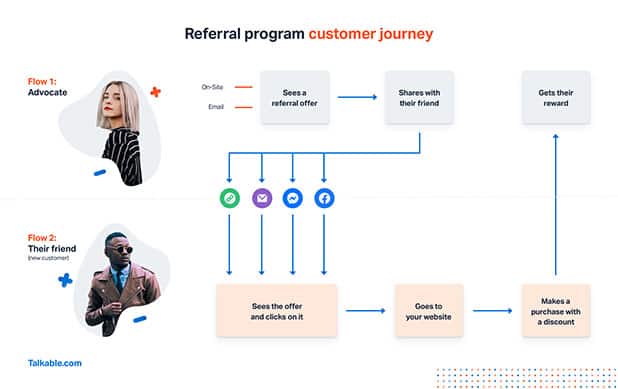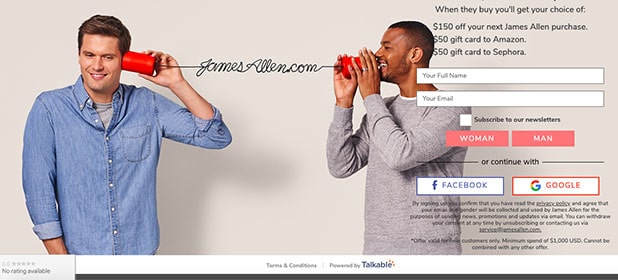Picture the ordinary Soul Kitchen cafe on the corner of the street that offers a free croissant with raspberry jam with the purchase of cappuccino during early morning hours.
One day, local resident George Mint gets into a habit of going to Soul Kitchen for a bite and a cup of coffee on his way to work. His breakfast tastes great, and George starts spreading the word about how great his corner cafe is and how tasty his breakfast became once he started going there.
The more he talks, the more his colleagues, friends, family members hear about Soul Kitchen. At least two of them come to try the tasty morning offer. Suddenly, chatter at George’s office and among George’s friends and family can help the cafe double their daily sales.
This is how people make decisions — we are influenced by the people close to us.
The Psychology of Referrals
Referral marketing, in simple terms, is the process of spreading information about a product or service through relationships with existing customers of your company.
Social psychologist Robert B. Cialdini explains the nature of this phenomenon: “We will use the actions of others to decide on proper behavior for ourselves, especially when we view those others as similar to ourselves.”

The main idea of referral marketing is to motivate happy customers to share your business with their friends. The logic of this chain is thus: the customer tells their friends about the business, they get a discount when making purchases, and then the business gets new customers.
In general, brands that use referral programs as a part of their marketing strategy can experience a 10 to 30% increase in customer acquisition. There is, of course, a point to consider: only companies that know how to target their customers just right can succeed at referral marketing.
For those companies who can do it, however, it’s a cost-effective way to attract new clients and grow revenue.
Let’s take a look at one of Talkable’s clients. Soko Glam is an online store that sells high-quality Korean skincare products and cosmetics. Their aim, just like other merchants, was not only to boost customer acquisition and sales but also build long-term relationships with their clients.
To meet their goals, Soko Glam decided to reward both their referring customers and the friends they referred to. The friend would get a 20% discount on any product on the Soko Glam website while the advocate earned $10 for their next order. Both sides ended up happy since the referral purchase rate increased by 34%.
There’s a social reason for this as well. When your best customers share your brand, their friends and family will trust their assessments. A referral from that customer sounds as powerful as a celebrity endorsement.
Why does this work so well?
Firstly, it would be logical to say a word about the nature of discounts at all. Most discounts work on the principle of urgency and are valid only for a certain period of time.
Discounting is sometimes tricky though, you want to do lots of them to keep customers coming back to your store, or shopping with you in the first place, but you also want to keep your profit margins high.
And using too many discounts, or using the wrong type could seriously cut into your profits.
So in order to make sure your strategy to work we suggest you to decide firm objectives to understand what you hope to achieve from discounting.
Then, ensure you have a good understanding of the right metrics you should be tracking so you can measure the effectiveness of your discounting strategy which works well with your pricing strategy.
Benefits of discounting
Increase sales volume
Think about it, everybody loves a deal and so if one of your objectives is to sell out on a certain line of stock. It makes both sides very happy.
Stand out from the competition
In the highly competitive world of e-commerce, you’re constantly vying for your customer’s attention competing with your competitors, not just on price but brand too. So, one way to stand out is by utilizing referral discounts.
Encourage new shoppers to spend their money with you
This is a great way to encourage customers to spend more money. When you bundle your products together and focus on increasing your average order value, it shows you more about your customer’s buying habits. Knowing their buying habits allows you to successfully tailor future deals to them.
Gain exposure during a specific holiday
Some events naturally encourage you to provide promotions or discounts and in fact, during these times customers expect discounts and some allow you to get really creative with your promotion strategy.
These special days include Black Friday and Cyber Monday, Boxing Day and New Years Day. You wouldn’t want to miss out on these days and without any discount, your store will not be even considered for consumers.
When Intermarché supermarkets in France offered a discount on Nutella hazelnut-chocolate spread, havoc broke loose. After the price was brought down by 70%, from €4.50 to €1.40 per jar, people began fighting.
Those who managed to grab the goods off the shelves and started crowding at the checkout stands. In some places, the police had to intervene.
This proves that people start to feel like they’re missing a chance to save money if they do not buy a product at a discounted price during a specific time.
Why do discounts work? It’s simple: they allow people to save money.
How do referral discounts work in reality?
As with all things connected to referral strategy design, value and incentives are critical elements for attracting clients. Your customers are interested in what your brand can give them, and they know your business needs them. The earlier you get an image of your consumer, the greater the reward will be.
Everything you want to give as a reward needs to correspond to what your business is selling, so as to attract customers instead of scaring them off. Here are five types of rewards:
- Gifts — stickers, T-shirts, or any other stuff related to your business.
- Added value — such as free delivery or additional services.
- Bonus points — bonuses that people can use for future purchases.
- Discounts — everyone loves lower prices.
- Credit — giving customers an amount of money to spend on their sum for their next purchase to encourage return business.
Referral marketing sends a very different message from mere referral discounts. Every referral program consists of three main components:
- A tracking mechanism (a link that tracks sign-ups and clicks)
- An incentive method (rules of the referral game)
- A reward (what your customer and their friend get from your company)
A referral program gives you maximum results with minimum effort.
Referral marketing campaigns break down into two categories by when they are applied:
- Pre-sale: when rewards for customers are offered before their purchase. This motivates people to make a purchase.
- After-sale: bonuses are given after purchase. The number of potential customers decreases, because not everyone is ready to buy something, twice more. Only loyal clients will act as advocates.
By including coupons and discounts in general marketing and pricing strategies, businesses will immediately get increased attention from customers.
However, in order to turn this attention into orders, it is important to understand that customers do not like doing math. They draw attention to the specific numbers in the proposal and come to conclusions based on this data.
According to studies, people prefer getting 50% of the same product for the same price than save 33% on the price, although mathematically it comes to the same thing.
The golden rule of referral discounts is 20 for 20. So to say, a customer shares a 20% discount with their friends and gets $20 for their next purchase.
At the same time, there are a couple of other factors to keep in mind.
Seasonality
One of the factors that strongly influence the success of a marketing plan building is the seasonality of the products sold. Some products, such as running shoes, are more popular in the summer than in the winter, whereas heaters sell better when it’s cold.
During seasonal sales, it’s necessary to make referral program time-limited or based on a particular occasion.
Products that are bought rarely
The specific nature of the product your business sells is critical to the end result of your program. For example, a person who buys a mattress will likely not have much need for a discount on a second one.
When someone buys a mattress, it’s because they need one, rather than because they’re a particular fan of the product. It is highly unlikely this person is a collector of beds to sleep on!
In this case, a rewards discount won’t have the desired effect. Instead, a business might try offering Amazon or Sephora gift cards as rewards.
James Allen is a shop that sells luxury diamond engagement rings. Usually, people don’t get engaged several times unless they are Julia Roberts in Runaway Bride!
As a result, James Allen gives referral customers a choice. As a reward, they can get a $50 Amazon or Sephora card, or $150 off the next purchase.

3) Other discounts
It might be like that you decided to run a referral discount and other special offers at the same time. The effort will be worth doing if you make a referral discount the highest.
Referral discounts use case
Looking at Talkable’s case study result as a whole, what we could already see is that one of the clients, a clothing shop, tripled their AOV by setting a minimum purchase amount of $50.
This result confirms what most people know but often forget: such kind of products are always in demand. Children grow up fast so obviously inspired parents will be always searching for new clothes and toys. How can such a simple principle be so significant?
Parents know that it’s better to have some items for their kids in reserve, and thus they don’t mind buying more using their earned discounts.
In order to encourage parents to spend money on items for their children both online and in-store, the store decided to send emails giving customers a bar code coupon that could be redeemed at the store’s physical locations.
So, consider sending emails with discounts or special offers.
Key Takeaways
- The more authority a person doing the referral has, the more likely the receiver is to take the offer.
- You can offer a variety of discounts, but a referral discount should be the most attractive.
- If the product is bought very rarely (like engagement rings), it’s better to offer a gift card instead of referral discounts.
- Referral marketing can easily boost sales up to 10%.


